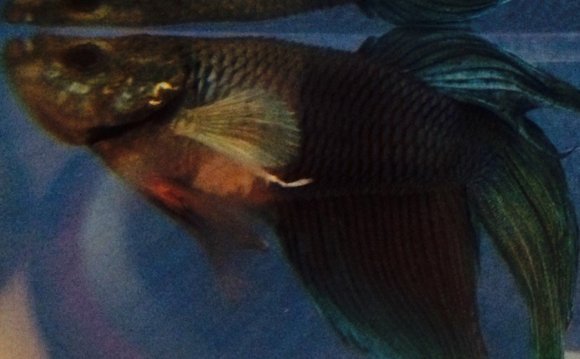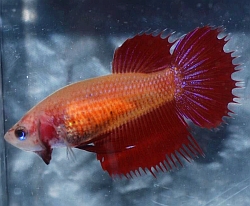
 Betta Fish Center > Purchasing Your Betta > How to Choose a Healthy Betta - Physical Signs
Betta Fish Center > Purchasing Your Betta > How to Choose a Healthy Betta - Physical Signs
It is important to know what to look for when buying a Betta from the pet store or fish dealer. Purchasing an unhealthy Betta can be disastrous. People who buy sick fish spend many distressing hours trying to improve its general health to no avail. These fragile fish do not recover easily from malnourishment or maltreatment.
Ask questions before making your purchase to ensure that the Betta was well cared-for at the pet store. Also, be attentive when bringing home your Betta to make sure he is still alive. Since Bettas are not very active, they could lie dead in a plastic bag or glass bowl without anyone noticing. Sometimes Bettas are already sick because of the less-than-healthy conditions in the fish tank. To guarantee the purchase of a healthy fish, visit only those dealers that have been referred or those that have a proven reputation.
Betta's Body
The body should be free of any kind of lumps or bumps. A healthy Betta has scales that are flat and smooth. Missing and loose scales signify a history of trauma and illness. White patches on the body could be indicative of a fungal infection. If its stomach is swollen, consider this a clear warning that the Betta is most likely not well.
Fins and Gills
When you extend the Betta’s fins, look for signs of discolorations, tears or holes. Sometimes this is difficult to properly check if the Betta is in a small container or jar at the pet store. Betta fins break or tear because they are kept for extended periods of time in containers too small for their bodies to move freely. Lastly, the gills should look smooth and flat with no signs of peeling, lumps or discoloration.
 Body Color
Body Color
Healthy Bettas are brightly colored with no apparent discoloration. Unhealthy Bettas have a pale appearance with some discoloration seen along their body or face.
Eyes
Healthy Betta fish have clear eyes. Do not buy Bettas if their eyes are sunken, bulging or glazed over.
Betta Behavior
Bettas are usually active and float upright, unless they are sleeping. Bring your hand close to the fish to make sure it is alert. Don't jab a finger into the bag in which it is stored or tap against its bowl or you will startle the fish. Rather, move your hand gently toward the Betta and gauge its reaction. Be subtle and gentle so as not to traumatize the fish. A healthy Betta is very alert and will always react to movement it detects.
Bubbles on the Surface
When you’re at the store trying to choose which betta to bring home, check to see if there are bubbles on the surface of the water in the bowl. Bubbles on the water’s surface usually means the betta is happy. But if there are no bubbles, that doesn’t automatically mean the betta is unhealthy. It’s just something to keep in mind, and it’s an issue that you can easily address once you get your betta home.
Mirror Trick
This is a fun one. Hold a mirror up to your betta – or hold your betta up to another betta – and gauge how he reacts. A healthy betta will quickly puff up in reaction to the “other” fish. Once you remove the threat (or, ahem, mirror), his gills should smoothly retract.
Even if you followed all these tips to choose a healthy betta, don’t freak out if you notice any changes in its behavior, activity level or appearance once you take it home. Like any animal, your fish will need some time to adjust to its new conditions, which may be very different from what it was accustomed to in the store.
However, there are a several ways to ease your betta’s transition to its new environment and to make sure the healthy fish you meticulously chose in the store stays that way in his new home.
Betta Quarantine Tank
The most important thing to remember is to give your betta time and space before you transfer him to your main aquarium. Set up a quarantine tank – separate from your main aquarium but with similar tank water conditions – where your new betta can acclimate for a few days, preferably a week.
A quarantine tank also helps ensure that your new fish isn’t sick and won’t introduce any diseases to your main aquarium, which shouldn’t happen if you followed all the steps for choosing a healthy betta, but still, better safe than sorry.
From the Bag to the Tank
Opening the pet store bag and plopping your betta into a tank will shock and stress your healthy fish. Don’t do it. Follow these steps to ease your betta into his quarantine tank.
1. Place the bag in the aquarium with the still-fastened end hanging out over the side. Let the bag float in the aquarium for 10 to 15 minutes so your betta can adjust to the new water temperature in the aquarium.









